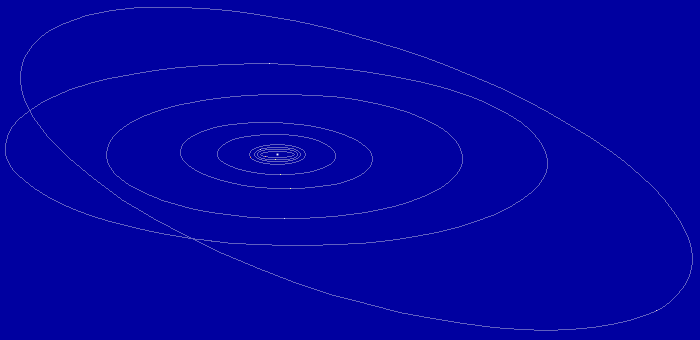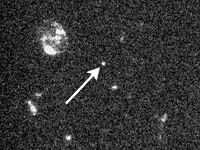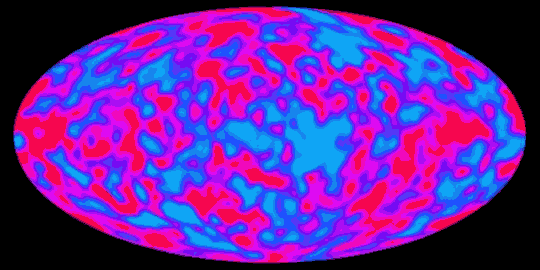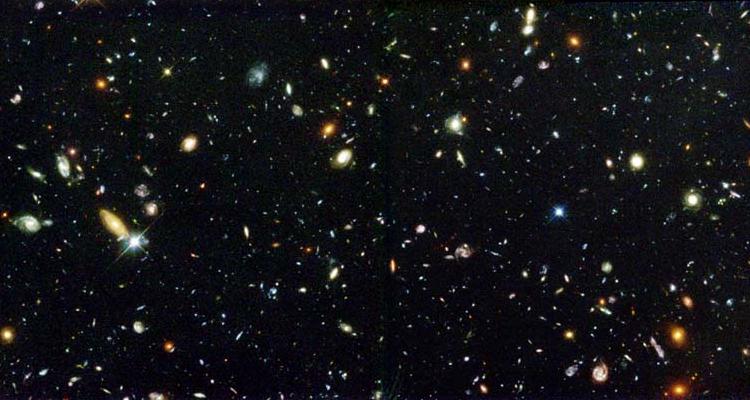


The length of a city block is something you're probably familiar
with. Imagine walking the length of a block. It takes
about 3 minutes.
Imagine 100 blocks end-to-end. That's the length of a largish city, like Minneapolis, where I live. It would take 20 minutes to drive from one end of the city to the other, if there were no traffic and no red lights to wait for. Walking the distance would take 5 hours.
![]()
Light, however, can go from one end of Minneapolis to the other in less than a ten-thousandth of a second. Light is the fastest thing there is. Nothing is faster.

The distance across the United States is about 200 times the length of
the city, so walking non-stop, without even a potty break, would take
1000 hours, or almost 42 days. Light crosses that distance in a
little more than 1/100th of a second. The country is very big,
but light is very, very fast.
The distance from Earth to the Moon is almost 100 times the width of the United States. It would take just about 11 years to walk to the Moon. Light goes from Earth to the Moon in less than 1.3 seconds.
Compared to any distance on Earth, the Moon is awfully far away. But light travels the distance in a heartbeat.
Pluto is the most distant known planet in our solar system: more
than 15,000 times farther from Earth than the Moon is. This is a
far bigger jump in scale than any of the previous increases. It
would take 167,000 years to walk to Pluto. Ughh! I think I'll
fly! Even light takes 5.5 hours to reach Pluto. At least that
is a comfortably familiar period of time. But compared to
1.3 seconds for light to reach the Moon, Pluto is terribly distant.

The star nearest our solar system is Proxima Centauri. It is 4.2 light-years away, which means that its light takes 4.2 years to get here. That is 6,700 times farther than Pluto. Another huge jump in scale -- much larger, for example, than the 200x jump from the width of a city to the width of the United States. You can pretty easily wait the 5.5 hours it takes for light to go from the Sun to Pluto, but waiting the 4.2 years it takes for light to get here from Proxima requires a good deal more patience. Even the very nearest star is incredibly far away.

Stars are scattered thinly throughout most of our galaxy, the Milky Way. Although the star nearest Earth is 4.2 light-years away, the average distance between nearest neighboring stars is about 10 light-years. Since there are at least 300 billion stars in the Milky Way, the galaxy must be unimaginably large. In fact, the visible disk is estimated to be 100,000 light-years in diameter. That is more than 20,000 times the distance to Proxima.
The largest jump in scale yet.
You might wait 4.2 years for light to travel to Earth from Proxima Centauri, but 100,000 years is longer, by far, than humans have been growing food crops or building permanent shelters. It is a length of time which cannot be experienced, and probably cannot really be comprehended. It suggests that the distance across the Milky Way is also beyond comprehension.

The nearest large galaxy to ours is the famous Andromeda Galaxy. It is very similar in size and shape to the Milky Way, and is the other major component of the Local Group of galaxies. It is the most distant thing which can be seen by the unaided eye. Light from Andromeda has traveled 3 million light-years to reach us. That is 30 times the diameter of the Milky Way. When starlight from Andromeda that we see now began its journey to Earth, human beings did not yet exist. Our ancestors had not yet learned how to make stone tools.

 The most distant galaxy yet seen directly (discovered in 1999) has
a redshift of 6.68, indicating that its light was emitted when the
Universe was only 5% of its present age. If the Universe is now
13.7 billion years old, the light has traveled 13 billion light-years
to reach us. That is 4,300 times the distance to the Andromeda
Galaxy. Yet another huge jump in scale. 13 billion years ago,
the cloud of dust and gas from which our solar system would form did
not yet exist.
The most distant galaxy yet seen directly (discovered in 1999) has
a redshift of 6.68, indicating that its light was emitted when the
Universe was only 5% of its present age. If the Universe is now
13.7 billion years old, the light has traveled 13 billion light-years
to reach us. That is 4,300 times the distance to the Andromeda
Galaxy. Yet another huge jump in scale. 13 billion years ago,
the cloud of dust and gas from which our solar system would form did
not yet exist.
The ultimate distance possible is the distance that light could travel since the beginning of the Universe in the Big Bang. All the light from that event was immediately absorbed (and re-emitted, and re-absorbed many times), but 380,000 years later the temperature had fallen enough for hydrogen atoms to form, causing the Universe to become transparent. This allowed light to travel unimpeded. Light from the hot, young Universe reaches us now, greatly red-shifted, as the cosmic microwave background radiation.

The background radiation has traveled nearly 13.7 billion light-years, or 4,600 times the distance to the Andromeda Galaxy.

Okay. Now for the answer to the question.
You remember the question:
How thick will the stack of paper be after
cutting it in half and stacking it 100 times?
Each time you cut the stack of paper in two, the number of pieces doubles: 2 x 2 x 2... one hundred times, or two to the 100th power, symbolized as 2100.
Two to the 100th power is 1,267,650,600,228,229,401,496,703,205,376.
In the US number naming system, it is one nonillion, 267 octillion, 650 septillion, 600 sextillion, 228 quintillion, 229 quadrillion, 401 trillion, 496 billion, 703 million, 205 thousand, 376.
With a calculator that shows enough digits, you can get this number simply by multiplying twos together, in less than a minute.
Multiplying by the thickness of the paper in millimeters (0.1 mm) gives the height of the stack in millimeters. Dividing the result by 1000 gives the height of the stack in meters. Dividing that by the number of meters in a light-year (9,460,536,000,000,000) gives the height of the stack in light-years.
Starting with a sheet of paper 0.1 millimeter thick, doubling the thickness one hundred times results in a stack 13.4 billion light-years tall. It would reach from Earth to beyond the most distant galaxy we can see with the most powerful telescopes -- almost to the edge of the observable Universe.

Part of the Hubble Space Telescope Deep Field - North. Nearly every spot of light is a galaxy.
If you find it hard to believe that just 100 cuts of the paper
will make the stack grow to such a height, here is
 To my Space and Science home page
To my Space and Science home page
Jeff Root
August 18, 2003